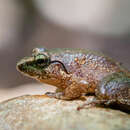en
names in breadcrumbs


The approximately 60 known species of the dicroglossid genus Limnonectes range from China south into Indonesia. This genus includes an unusual diversity of breeding biologies that range from exotrophic tadpoles to endotrophic development in terrestrial nests (Kusrini et al. 2015).
Limnonectes is a genus of fork-tongued frogs of about 75 known species, but new ones are still being described occasionally.[1][2] They are collectively known as fanged frogs because they tend to have unusually large teeth, which are small or absent in other frogs.
These frogs are found throughout East and Southeast Asia, most commonly near forest streams. Multiple species of Limnonectes may occupy the same area in harmony.[3] Large-bodied species cluster around fast rivers, while smaller ones live among leaf-litter or on stream banks. The Indonesian island of Sulawesi is home to at least 15 species of this frog, only four of which have been formally described.[4]
Tadpoles of this genus have adapted to a variety of conditions. Most species (e.g. Blyth's river frog L. blythii or the fanged river frog L. macrodon) develop normally, with free-swimming tadpoles that eat food.[5] The tadpoles of the corrugated frog (L. laticeps) are free-swimming but endotrophic, meaning they do not eat but live on stored yolk until metamorphosis into frogs.[5] Before, L. limborgi was assumed to have direct development (eggs hatching as tiny, full-formed frogs), but more careful observations have showed it has free-swimming but endotrophic larvae; this probably applies to the closely related L. hascheanus, too.[6] L. larvaepartus is the only known species of frog that gives live birth to tadpoles.[4] Parental care is performed by males.[3]
The following phylogeny of Limnonectes is from Pyron & Wiens (2011).[8] 35 species are included. Limnonectes is a sister group of Nanorana.[8]
LimnonectesThe following Limnonectes phylogeny is from Aowphol, et al. (2015).[9] 20 species are included.
LimnonectesBelow is a phylogeny of species within the L. kuhlii species complex (McLeod, et al. 2015).[10] Limnonectes longchuanensis, Limnonectes hikidai, and Limnonectes cintalubang[11] are also part of the L. kuhlii species complex.
Limnonectes is a genus of fork-tongued frogs of about 75 known species, but new ones are still being described occasionally. They are collectively known as fanged frogs because they tend to have unusually large teeth, which are small or absent in other frogs.